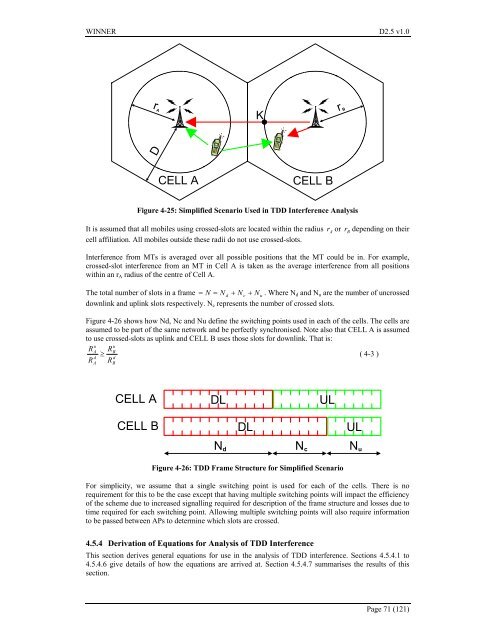IST-2003-507581 WINNER D2.5 v1.0 Duplex ... - Celtic-Plus
IST-2003-507581 WINNER D2.5 v1.0 Duplex ... - Celtic-Plus
IST-2003-507581 WINNER D2.5 v1.0 Duplex ... - Celtic-Plus
- No tags were found...
You also want an ePaper? Increase the reach of your titles
YUMPU automatically turns print PDFs into web optimized ePapers that Google loves.
D<strong>WINNER</strong> <strong>D2.5</strong> <strong>v1.0</strong>rAKr BCELL ACELL BFigure 4-25: Simplified Scenario Used in TDD Interference AnalysisIt is assumed that all mobiles using crossed-slots are located within the radius rAor rBdepending on theircell affiliation. All mobiles outside these radii do not use crossed-slots.Interference from MTs is averaged over all possible positions that the MT could be in. For example,crossed-slot interference from an MT in Cell A is taken as the average interference from all positionswithin an r A radius of the centre of Cell A.The total number of slots in a frame = N = Nd+ Nc+ Nu. Where N d and N u are the number of uncrosseddownlink and uplink slots respectively. N c represents the number of crossed slots.Figure 4-26 shows how Nd, Nc and Nu define the switching points used in each of the cells. The cells areassumed to be part of the same network and be perfectly synchronised. Note also that CELL A is assumedto use crossed-slots as uplink and CELL B uses those slots for downlink. That is:u uRARBd ≥d( 4-3 )R RABCELL ADLULCELL BDLULNd Nc NuFigure 4-26: TDD Frame Structure for Simplified ScenarioFor simplicity, we assume that a single switching point is used for each of the cells. There is norequirement for this to be the case except that having multiple switching points will impact the efficiencyof the scheme due to increased signalling required for description of the frame structure and losses due totime required for each switching point. Allowing multiple switching points will also require informationto be passed between APs to determine which slots are crossed.4.5.4 Derivation of Equations for Analysis of TDD InterferenceThis section derives general equations for use in the analysis of TDD interference. Sections 4.5.4.1 to4.5.4.6 give details of how the equations are arrived at. Section 4.5.4.7 summarises the results of thissection.Page 71 (121)
















